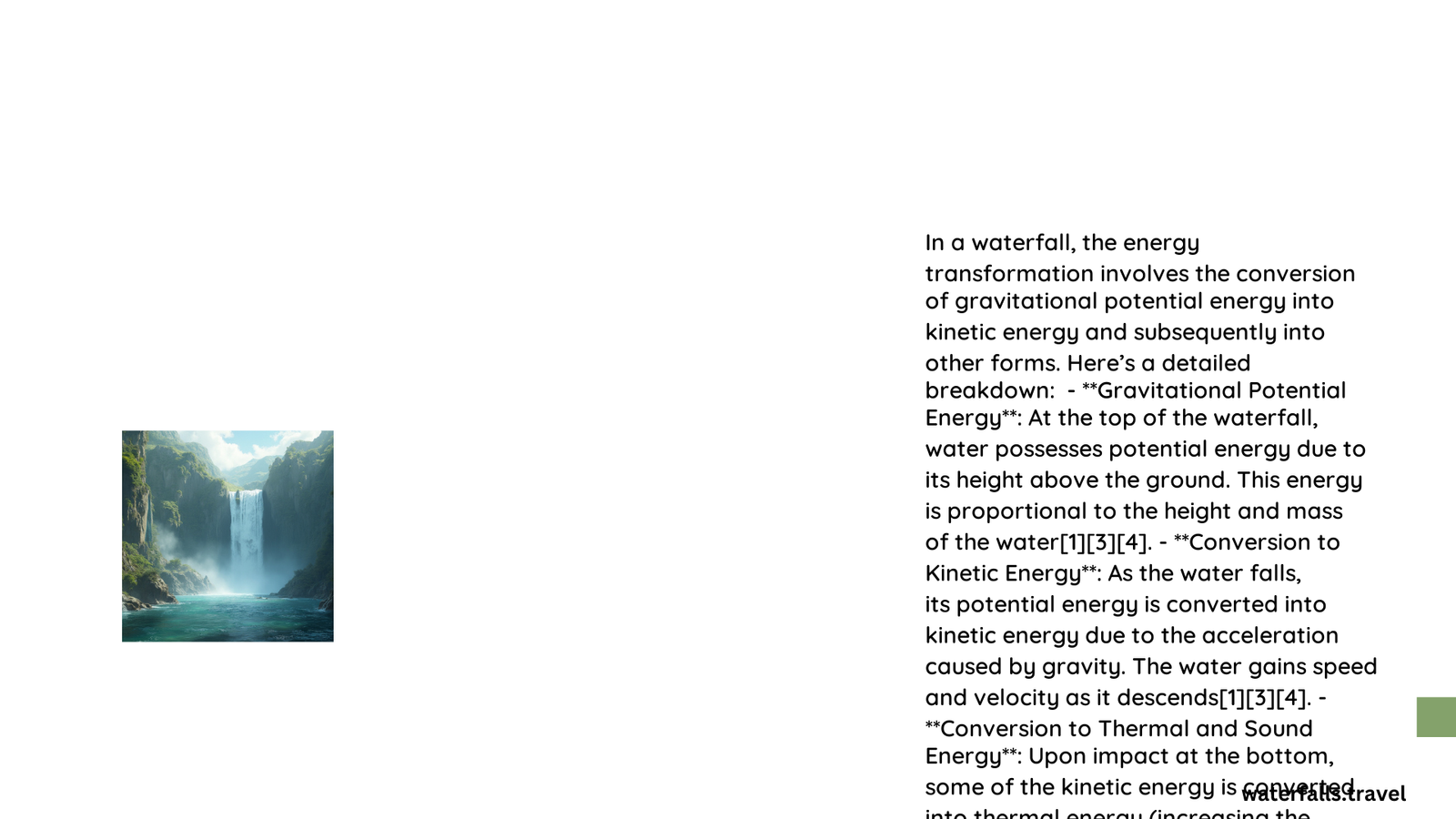A waterfall’s energy transformation is a captivating process where gravitational potential energy converts to kinetic energy as water descends. This phenomenon, governed by the Law of Conservation of Energy, showcases nature’s power and efficiency. Understanding this transformation provides insights into hydropower generation and the fundamental principles of physics that shape our world.
What is the Primary Energy Transformation in a Waterfall?
The primary energy transformation in a waterfall is the conversion of gravitational potential energy to kinetic energy. This process occurs as water moves from a higher elevation to a lower one, following these steps:
- At the top of the waterfall, water possesses gravitational potential energy due to its height.
- As the water falls, this potential energy gradually converts to kinetic energy.
- At the bottom of the waterfall, the water’s energy is predominantly kinetic.
How is Gravitational Potential Energy Calculated?

Gravitational potential energy is calculated using the formula:
[ E_g = mgh ]
Where:
– E_g is the gravitational potential energy
– m is the mass of the water
– g is the acceleration due to gravity (approximately 9.81 m/s²)
– h is the height of the waterfall above the base
What is the Formula for Kinetic Energy?
Kinetic energy is given by the formula:
[ E_k = \frac{1}{2} mv^2 ]
Where:
– E_k is the kinetic energy
– m is the mass of the water
– v is the velocity of the water
Can You Provide an Example Calculation?
Let’s consider Victoria Falls, one of the world’s largest waterfalls, with a height of approximately 108 meters.
For 1 kilogram of water:
[ E_g = 1 \, \text{kg} × 9.81 \, \text{m/s}^2 × 108 \, \text{m} = 1060.68 \, \text{J} ]
This gravitational potential energy converts to kinetic energy at the bottom:
[ E_k = 1060.68 \, \text{J} = \frac{1}{2} × 1 \, \text{kg} × v^2 ]
Solving for v:
[ v = \sqrt{2 × 1060.68 \, \text{J} / 1 \, \text{kg}} ≈ 46 \, \text{m/s} ]
How Does Hydropower Generation Utilize This Energy Transformation?
Hydropower systems harness the energy transformation in waterfalls to generate electricity through the following process:
- Water stored behind a dam or at the top of a waterfall has high gravitational potential energy.
- As the water flows down through turbines, this potential energy converts to kinetic energy.
- The kinetic energy of the water turns the turbines, which are connected to generators.
- The generators produce electricity from the mechanical energy of the spinning turbines.
What Factors Affect the Efficiency of Hydropower Systems?
Several factors influence the efficiency of hydropower systems:
- Head (height) of the water
- Flow rate
- Turbine design
- Generator efficiency
- Environmental conditions
Typical hydropower system efficiencies range from 90% to 95%, making them one of the most efficient forms of energy generation.
How is the Energy Output of a Hydropower System Calculated?
The energy output of a hydropower system depends on two main factors:
- Flow rate (Q)
- Head (H)
The power output can be calculated using the formula:
[ P = ηρgQH ]
Where:
– P is the power output in watts
– η is the efficiency of the system
– ρ is the density of water (1000 kg/m³)
– g is the acceleration due to gravity (9.81 m/s²)
– Q is the flow rate in m³/s
– H is the effective head in meters
What are the Costs and Maintenance Considerations for Hydropower Facilities?
Hydropower facilities involve significant initial investment but offer long-term benefits:
| Aspect | Details |
|---|---|
| Initial Cost | High – includes dam construction, turbines, generators, and infrastructure |
| Maintenance Cost | Relatively low compared to other power generation methods |
| Lifespan | Long – typically 50-100 years |
| Fuel Cost | None – water is the fuel source |
How Can Visitors Learn About Energy Transformation at Waterfalls?
Many waterfalls offer educational opportunities for visitors to learn about energy transformation:
- Guided tours explaining the science behind waterfalls
- Educational programs at nearby hydropower plants
- Informational displays and exhibits at visitor centers
- Interactive demonstrations of energy conversion principles
For example, Niagara Falls State Park offers guided tours and educational programs that include information on the hydropower generation at the Niagara Power Plant.
By understanding the energy transformation that occurs in a waterfall, we gain insight into the fundamental principles of physics and the potential for harnessing natural energy sources. This knowledge is crucial for developing sustainable energy solutions and appreciating the power of nature.
References:
1. http://tonkaenergy.weebly.com/waterfall-energy.html
2. https://energyeducation.ca/encyclopedia/Gravitational_potential_energy
3. https://www.vaia.com/en-us/textbooks/physics/the-physics-of-everyday-phenomena-a-conceptual-introduction-to-physics-6-edition/chapter-10/problem-20-based-upon-his-experiments-joule-proposed-that-th/
